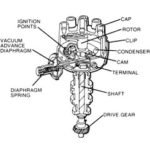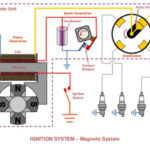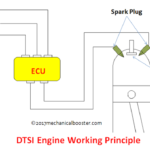Introduction
“Mechanical component shows wear and tear” this theory wakes up an engineer’s mind and forces him to innovate more to achieve an ideal system, Since the moving mechanical components cause wear and tear which we count as a limitation of the component, the questions arise, Can we avoid the use of distributor in an ignition system? If yes, then how can we manage the timing of the spark in multiple-cylinder engines? The answer is a Distributorless Ignition System (DIS) which can manage the timing of the spark easily.
Distributorless Ignition System (DIS)
DIS is the ignition system in which the distributor of the electronic ignition system is replaced with the number of induction coils i.e. one coil per cylinder or one coil for a pair of cylinders, and the timing of the spark is controlled by an Ignition control unit (ICU) and the Engine control unit (ECU), which makes this system more efficient and accurate.
Due to the use of multiple ignition coils that provide direct voltage to the spark plugs. this system is also known as Direct Ignition System (DIS).
Why Do We Need a Distributorless Ignition System?
As we know all the ignition systems introduced lately are –
1. Glow plug ignition system
2. Magneto ignition system
3. Electric coil ignition system
4. Electronics ignition system
Were a result of improvements in the later system respectively to make the ignition system of a vehicle more reliable and effective, The latest of all from the above is, Electronic ignition system which is used in almost all the latest super and hyper series cars and bikes but it is found that this system also bears some limitations that made it necessary to develop a system that can overcome these limitations which are as follows-
(i) Electronic ignition system uses a distributor which is used to distribute the high-voltage signal from the ignition module to the spark plugs, the distributor used is a mechanical device having a rotor that completes the circuit and also controls the spark timing, which makes this system little less efficient and this system also faces mechanical and electrical wear and tear.
(ii) Electronic ignition system requires higher maintenance than a distributorless ignition system i.e. service period for an electronic ignition system is 25,000 miles and that of distributorless ignition system is 1,00,000 miles.
(iii) Distributor in the electronic ignition system requires a periodic check for the distributor’s point gap as they are subjected to wear and tear.
(iv) The spark timing accuracy of the electronic ignition system decreases with time.
These problems gave rise to the development of a smart ignition system named the Distributorless ignition system in which the spark time accuracy is increased using an electronic control unit along with an ignition module and the distribution of the voltage signal to the spark plugs is made directly using multiple ignition coils, which decreases the wear and tear of the system and makes the system most efficient and reliable ignition system till date.
Also Read:
- How Disc Brake Work? – Best Explanation
- How DTSi Engine Works – Explained?
- What is Firing Order of 4 and 6 Cylinder Engine?
Distributorless Ignition System Diagram

Main Parts of DIS
The components of this ignition system is same as electronic ignition system but there is no distributor in this system, the components used are-
1. Battery:
Same to the electronic ignition system, the battery is used as the powerhouse for the DIS.
2. Ignition Switch:
It governs the ON and OFF of the ignition system, the same as the electronic ignition system.
3. Ignition coil and Ignition Control Module
In the distributorless ignition system, a complete assembly of ignition coils and module is used to make the system compact and less complicated.
(i) Ignition Coils: Unlike the electronic ignition system in which a single ignition coil is used to generate high voltage , DIS uses a number of ignition coils i.e. each coil per spark plug which generates high voltage individually for each spark plug.
(ii) Ignition Control Module (ICM) or Ignition Control Unit: It is the programmed instruction given to the chipset which is responsible for setting the primary coil circuit to ON or OFF,
4. Magnetic Triggering Devices:
These are the devices used to control the timing of the spark plug by sensing the position of the crankshaft and camshaft both, a magnetic triggering device consists of triggering wheel having teeth along with a sensor, two magnetic triggering devices are used in Distributorless ignition system that are-
(i) Camshaft Triggering Device: Mounted on the camshaft and used for sensing valve timing.
(ii) Crankshaft Triggering Device: Mounted on the crankshaft and used for sensing the piston position or stroke.
5. Spark Plug:
It is used to generate a spark inside the cylinder.
Also Read:
- How Drum Brakes Work?- Easiest Explanation Ever
- How Spark Ignition Engine Works?
- Different Types of Engine
Working of Distributorless Ignition System

- When the ignition switch is turned ON, the current from the battery starts to flow through the ignition switch to the electric control unit (which keeps on processing data and calculating timing) of the vehicle which is connected to the ignition module and coils assembly,(which makes and breaks the circuit).
- The triggering wheels mounted on the camshaft and crankshaft have equally spaced teethes with one gap, and the position sensors which consists of the magnetic coil that constantly generates magnetic field as the camshaft and crankshaft rotates.
- When these gaps come in front of the positioning sensors, fluctuation in the magnetic field occurs and the signals of both the sensors are sent to the ignition module which in turn senses the signals and the current stops to flow in the primary winding of the coils .and when these gaps go away from the sensors the signals of both the sensors are sent to the ignition module which turns ON the current to flow in the primary winding of the coils.
- This continuous make and break of the signals generate magnetic field in the coils which in turn induced EMF in the secondary winding of the coils and increases the voltage up to 70,000 volts.
- This high voltage is then sent to the spark plugs and the generation of sparks takes place.
- The timing of the spark plugs is controlled by an electronic control unit by continuously processing the data received from the ignition control module.
For a Better Explanation Watch the Video Given Below:
Application of Distributorless Ignition System
- A distributorless ignition system (DIS) has been used for a decade. now, almost all the cars with 1.8 L, 2.8 L VR6, AND 2.8 L V-6 engine on the road uses this system.
- DIS was first used in 2.8 L VR6 engine-equipped Volkswagen Passat.
- Some high end bikes like Ducati Super sports also adopt this system.
Conclusion
In this article, you have learned about how a Distributor Less Ignition System Works. I hope you have understood it clearly without any difficulty and if you found this piece of information useful and valuable then don’t forget to like and share it.








